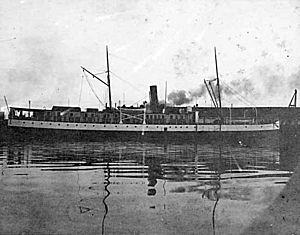Cutch (steamship) facts for kids

Cutch in Canadian service before 1898.
|
|
Quick facts for kids History |
|
|---|---|
| Name | Cutch |
| Route | coastal British Columbia |
| In service | 1884 |
| Identification | Canada registry #100202; US registry 77526; flag signal K.R.Q.S. |
| Fate | Transferred to Colombia, renamed Bogota |
| General characteristics | |
| Type | Coastal steamship |
| Tonnage | as built : 324 gross tons; rebuilt: 676 gross tons |
| Length | 180 ft (54.9 m) |
| Beam | 23 ft (7.0 m) |
| Depth | 12 ft (3.7 m) depth of hold |
| Installed power | double expansion steam engine, coal-fired boiler. |
| Sail plan | auxiliary schooner |
| Speed | 12 miles per hour nominal |
| Capacity | 1890: 150 pass.; 1898: 210 pass. |
The Cutch was a steamship built in 1884 in Hull, England. This ship had a very interesting life! It started as a special boat for religious journeys and a fancy yacht in India. Later, it became a passenger ship in British Columbia, Canada.
After a shipwreck, it was fixed up and renamed Jessie Banning in the United States. Then, it was sold to the navy of Colombia and became a powerful gunboat called Bogota. In 1903, the Bogota was involved in a historic event when it fired shots towards the city of Panama during the separation of Panama from Colombia.
Contents
Building the Cutch
The Cutch was built in 1884 by James Brunner & Co. in Hull, England. It was ordered by Jumabhoy Lolljee from Bombay, India. He wanted a fast ship to carry people on religious trips.
The ship had its first test run on July 1, 1884. It sailed at Withernsea, near the Humber Estuary. The Cutch reached speeds of over 12 knots (about 14 miles per hour). This was very fast for its time!
When it was first built, the Cutch was 180 feet (55 meters) long. It was 23 feet (7 meters) wide and 12 feet (3.7 meters) deep. The ship was made of iron and weighed 324 gross tons.
Engine and Power
The Cutch used a special type of steam engine called a "double-expansion" engine. This engine was powered by a boiler that burned coal. It could make the ship travel at about 12 miles per hour.
The engine used steam at 100 pounds of pressure. At top speed, it turned 92 times per minute. The ship also had sails like a schooner. This meant it could use wind power too, which was helpful if the engine had problems or to save coal.
Journey to Canada
In 1890, the Union Steamship Company bought the Cutch. The ship was no longer needed as a yacht by the Maharajah of Cutch (India). Captain William Webster, who managed the company, sailed the ship all the way from India to British Columbia.
The Cutch arrived in British Columbia in June 1890. It was allowed to carry 150 passengers in Canada.
Life as a Canadian Steamship
From 1892 to 1896, the Cutch sailed a regular route. It traveled from Vancouver to Nanaimo, British Columbia. It also stopped at Steveston along the way.
The Cutch carried passengers for the Canadian Pacific Railway. This railway had train stations in Vancouver and Nanaimo. At that time, the railway company did not have its own ships.
Big Changes and New Routes
In 1898, the Cutch was rebuilt. It got new engines and more cabins. This allowed it to carry 60 more passengers. The ship also became much bigger, growing from 324 to 676 gross tons.
After its rebuild, the Union Steamship Company sent the Cutch on a new route. In 1898 and 1899, it sailed north on the Inside Passage. This route went to Skagway and Dyea, Alaska. These towns were important during the gold rush.
Wreck and New Name
On August 24, 1900, the Cutch was wrecked. This happened in Stephens Passage, Alaska. The ship was sold for its parts and then pulled to Portland, Oregon.
In 1901, the ship was registered in the United States. It was given a new name: Jessie Banning. Its new homeport was Seattle, Washington. The ship's size was listed as 639 gross tons.
Becoming a Colombian Gunboat
In 1902, the ship was sold again. It went to Colombia and was renamed Bogota. The Colombian navy used it as their strongest ship on the Pacific Coast.
The Bogota was turned into a warship. It was armed with one 14-pounder gun. It also had eight fast-firing 6-pounder cannons. Plus, it carried two Vickers-Maxim machine guns.
Even though it was supposed to go 12 miles per hour, its engines were old. So, it usually only went about 9 miles per hour.
Role in Panama's History
On November 3, 1903, the Bogota played a part in history. During the separation of Panama from Colombia, the ship fired some shots towards the city of Panama. This event was connected to the building of the Panama Canal.
See also
 In Spanish: Cutch (vapor) para niños
In Spanish: Cutch (vapor) para niños


